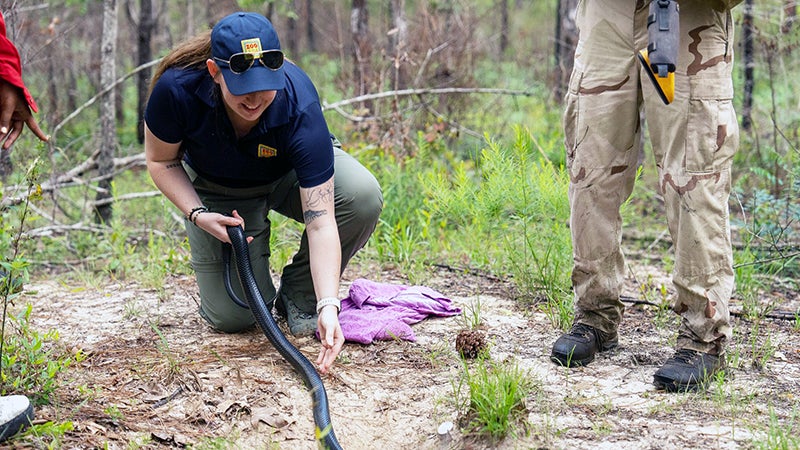Eastern indigo snakes released into Conecuh National Forest
Published 7:30 am Friday, May 19, 2023

- A Central Florida Zoo and Botanical Gardens official releases an eastern indigo snake in the Conecuh National Forest on Friday, May 12. (PHOTO PROVIDED)
|
Getting your Trinity Audio player ready...
|
There’s a new ruler of the Conecuh National Forest in Alabama—17 of them, to be exact.
The Central Florida Zoo and Botanical Gardens’ Orianne Center for Indigo Conservation (OCIC) today reintroduced its latest cohort of nonvenomous apex predator eastern indigo snakes. This brings to total of the threatened species reintroduced to its native territory to 244 for the Conecuh National Forest.
The OCIC is the only captive breeding facility for the eastern indigo snake with the sole purpose of releasing the offspring into regions where the population has been extirpated. The snake — which is America’s longest — has in recent years been deeply restricted due to habitat loss, habitat fragmentation and the decline of gopher tortoises, whose burrows the snakes rely on for shelter. With efforts like those of the OCIC, the population has begun to rebound in native lands like the Conecuh National Forest.
The snakes start their life at the OCIC’s facilities in Lake County, Florida, where they are bred and hatched. After a year, they are transferred to Zoo Atlanta, where they grow and are prepared for release.
Native to the southern longleaf pine ecosystems of Georgia, Alabama, Mississippi and Florida, the snake is essential for habitat balance, as it eats small animals and other venomous and nonvenomous snakes.
“So many people put so much effort into the breeding and care of these snakes,” said OCIC Director Dr. James Bogan. “A day like today makes that incredibly rewarding, as we watch this essential apex predator reclaim its territory and restore balance to the ecosystem.”
A variety of partners help make releases like this possible. On this release, the OCIC worked with the U.S. Fish and Wildlife Service (USFWS), Alabama Department of Conservation and Natural Resources (ALDCNR), The Orianne Society, Auburn University, The Nature Conservancy, US Forest Service, Zoo Atlanta, Welaka National Fish Hatchery, Joseph W. Jones Ecological Research Center, Alabama Natural Heritage Museum, and others.
This is just one of several releases the OCIC works on yearly. Just last month the nonprofit helped release 19 eastern indigos at The Nature Conservancy’s Apalachicola Bluffs and Ravines Preserve, bringing the total released there to 126.
Through field cameras and pedestrian survey sightings, the OCIC and its partners have seen evidence that these released snakes continue to thrive in their native habitat.
For more information about the OCIC, visit https://www.centralfloridazoo.org/about-the-zoo/ocic.
About the Central Florida Zoo & Botanical Gardens
The Central Florida Zoo & Botanical Gardens is home to over 300 animals in Sanford, Florida. As a not-for-profit organization, it is a leader in conservation, creating connections that inspire people to take action for wildlife. More information is available at www.centralfloridazoo.org.




